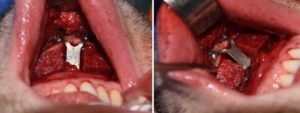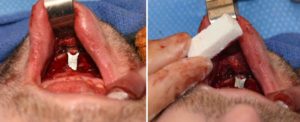Background: In chin augmentation treatment options consist of either an implant placed on top of the bone or to move the chin bone forward. (sliding genioplasty) Often it is perceived that these two chin enhancement methods are competitive options but that is not really the case. Conversely each method has distinct advantages and disadvantages which must be considered on an individual case basis.
The sliding genioplasty is a chin bone procedure that has been around for a long time. While it has evolved in its technique over the years from its namesake (it really doesn’t slide forward along the bone cut as it has been historically described), it does move the edge of the chin bone forward. What is often not appreciated about the procedure is that it is really a pedicled myo-osseous bone flap. Its posterior preserved muscle attachments is how the bone survives after it is cut off from the upper chin bone. As a result of these attachments the geniohyoid and genioglossus muscles are pulled forward which can have a positive neck contouring (lifting) effect.
It is my opinion that in severely short chins (greater than 10mm to 12mms horizontal deficiency) an implant is not the best long chin augmentation procedure for some patients. There are other anatomic issues around the chin that need to be improved which an implant can not do. At the very least if the sliding genioplasty is still aesthetically insufficient, it serves as an improved foundation for an implant to be done later.
Case Study: This young male had a severe chin deficiency that ensures as 18mm short by the classic vertical line down from the lip measurement. He was also vertically short in wore facial height as is often common in severe lower jaw deficiency. However he had an orthodontically corrected occlusion which negated the possibility of total lower jaw advancement surgery.


Case Highlights:
1) A sliding genioplasty is the autologous option in chin augmentation
2) In severely short chins, a sliding genioplasty is preferred over an implant as it establishes a solid bony base and pulls certain neck muscle forward.
3) In large sliding genioplasty advancements, an interpositional graft is helpful for both long-term healing and bony stability.
Dr. Barry Eppley
Indianapolis, Indiana



